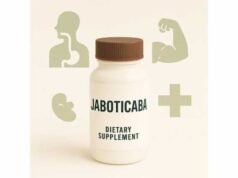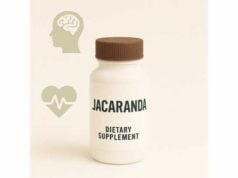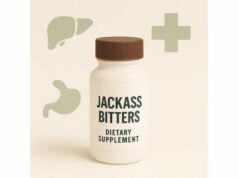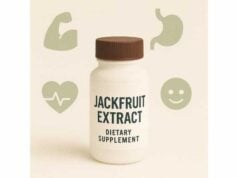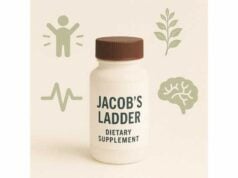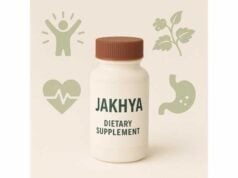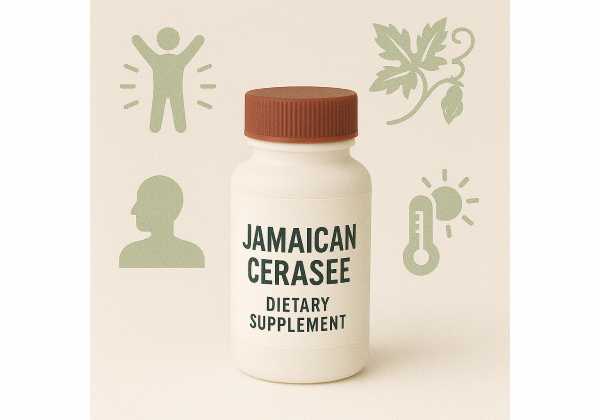
Jamaican cerasee is one of the Caribbean’s most recognizable “bush teas.” Known elsewhere as bitter melon or bitter gourd (Momordica charantia), this vine’s leaves and stems are boiled to make a distinctly bitter tea used for “cleansing,” digestive upset, colds, skin wash, and—most commonly—blood sugar support. Modern research focuses on its potential effects on glucose metabolism, insulin resistance, and cholesterol, while traditional practices emphasize periodic tea use and topical washes. If you’re curious about what the evidence actually shows, which forms make sense, and how to use cerasee safely, this guide walks through the essentials with practical steps and clear safety guardrails.
Quick Overview
- May modestly lower fasting glucose and A1C in some adults over 8–12 weeks; effects vary by product and dose.
- Typical supplement amounts are 500–1,000 mg taken 2–3 times daily; tea is usually 1 cup (250 mL) brewed from 1–2 g dried herb, up to 1–3 times daily.
- Can cause gastrointestinal upset, dizziness, or low blood sugar—especially with diabetes medications.
- Avoid in pregnancy and while breastfeeding; not for children without clinician guidance or for anyone with upcoming surgery unless your clinician approves.
Table of Contents
- What is Jamaican cerasee?
- Does cerasee work for blood sugar and cholesterol?
- How to use cerasee tea and supplements
- How much cerasee to take per day
- Side effects, interactions, and who should avoid it
- Evidence snapshot and a smart product checklist
What is Jamaican cerasee?
Cerasee is the Jamaican name for the vine Momordica charantia, a member of the Cucurbitaceae (gourd) family. Across the Caribbean, households commonly boil its fresh or dried leaves and stems to make a strong, bitter tea. Globally, the same plant is called bitter melon or bitter gourd and is also eaten as a vegetable in many Asian cuisines. While the fruit is widely cooked, the Jamaican tea tradition usually relies on the vine’s leaves and tender stems rather than the fruit itself.
The plant’s bitterness comes from cucurbitane-type triterpenoids and saponins. In laboratory and animal studies, extracts of bitter melon have shown mechanisms that might influence glucose handling—such as effects on glucose transport, insulin signaling, intestinal carbohydrate digestion, and hormones that regulate blood sugar after meals. Traditional uses in the Caribbean extend beyond sugar control, including “blood cleansing,” constipation, skin rashes (as a wash), and seasonal “detox” periods. These cultural practices often involve short courses (a few days to a couple of weeks), not continuous year-round intake.
It’s important to separate plant parts and preparations. A cup of homemade tea from dried leaves is not equivalent to a standardized capsule made from fruit extract, and neither equals freshly cooked fruit. Many studies use concentrated extracts with specified doses that don’t map directly to home tea recipes. As a result, people can have very different experiences even when they believe they’re using “the same” cerasee.
Finally, taste matters. Cerasee is intensely bitter—some drink it straight, while others add ginger, lime, or a small amount of honey to make it more palatable. If you’re new to it, start with a mild brew to see how your stomach and blood sugar respond before making it stronger.
Does cerasee work for blood sugar and cholesterol?
The short answer: results are mixed. Two recent systematic reviews and meta-analyses assessed randomized controlled trials of Momordica charantia and reached different conclusions—one found statistically significant reductions in fasting glucose, post-meal glucose, A1C, and total cholesterol over 8–16 weeks, while another judged the overall clinical effect to be uncertain due to inconsistent findings, short study durations, and variability in products and dosing. These conflicting results highlight a key reality: outcomes depend heavily on the extract used, the amount taken, the study population (prediabetes vs. type 2 diabetes), and whether participants are also using glucose-lowering medications.
What can you reasonably expect?
- Fasting and post-meal glucose: Some trials report reductions in fasting glucose of roughly 0.8–1.0 mmol/L and meaningful drops in post-meal spikes after 8–12 weeks of daily supplementation. Others show little to no change compared with placebo.
- A1C (three-month average): Modest reductions (about 0.3–0.4 percentage points) have been observed in some analyses, but not consistently across all studies.
- Lipids: Total cholesterol sometimes decreases, while LDL, HDL, and triglycerides are less consistently affected.
- Weight and blood pressure: Most trials don’t show reliable changes in body weight or blood pressure over short study periods.
Why the variability? Many reasons: different plant parts (fruit vs. whole plant), extraction methods (water, ethanol, supercritical CO₂), standardization markers (e.g., “charantin”), and dose schedules. Study durations are often too short to capture A1C changes robustly, and participant lifestyles and medications can overshadow subtle effects from a supplement.
What does this mean for you?
- If you have prediabetes or diet-controlled type 2 diabetes, a structured 8–12-week trial with a consistent product and regular glucose monitoring may clarify whether cerasee helps you.
- If you’re already on insulin or sulfonylureas, any additional glucose-lowering effect increases the risk of hypoglycemia. Use only under clinician supervision with a clear monitoring plan.
- Cerasee is not a replacement for prescribed diabetes care. Think of it as a potential adjunct to diet, exercise, sleep, and medications—not a standalone solution.
Bottom line: there’s suggestive but inconsistent clinical evidence for modest improvements in glycemic control and possibly total cholesterol over a few months. Benefits, if any, tend to be small and product-specific, and safety monitoring is essential in people taking glucose-lowering drugs.
How to use cerasee tea and supplements
Decide your form first. Your options are (1) homemade tea (leaves/stems), (2) standardized capsules or tablets (usually fruit extract but sometimes whole-plant), and (3) culinary use (cooked fruit). Each path has different pros and cons.
1) Tea (leaves and stems)
- How to brew: Add 1–2 grams of dried cerasee (about 1–2 teaspoons, loosely packed) to 250 mL (1 cup) of hot water. Simmer gently 5–10 minutes; cover while steeping. Strain and drink warm.
- How often: Many people start with 1 cup per day for 2–3 days to gauge tolerance. If well-tolerated, increase to 1–3 cups per day as needed for short stints (for example, several days per week or a 1–2-week period), then reassess.
- Taste tips: To soften bitterness, add a squeeze of lime, a thin slice of ginger, or a small amount of honey. Don’t mask the bitterness with large amounts of sugar if blood sugar control is your goal.
- Topical use: Some households cool the tea and apply as a skin wash for itchy rashes. If you have sensitive skin or an open wound, skip this and consult a clinician.
2) Standardized capsules or tablets
- What labels claim: You’ll see strengths like 500 mg, 750 mg, or 1,000 mg per capsule, often taken two or three times daily. Some labels refer to “charantin,” “polypeptide-p,” or “bitter melon extract” without specifying the plant part.
- How to start: Begin at the low end (e.g., 500 mg with food once daily for 3–4 days), then step up gradually to the intended schedule.
- Consistency matters: Use the same product for at least 8 weeks before judging effect. Swapping brands mid-trial makes it hard to interpret your glucose logs.
3) Culinary use (cooked fruit)
- As a vegetable: Stir-fry, steam, braise, or stuff the fruit. Light salting and rinsing before cooking can reduce bitterness.
- Portion control: Cooking methods vary widely and won’t match standardized trial doses. Enjoy as part of a balanced meal pattern rather than relying on it for therapeutic dosing.
Combine with monitoring. If you track fasting glucose, post-meal readings (1–2 hours after eating), and periodic A1C (via your clinician), you’ll know within 8–12 weeks whether cerasee adds value for you. Document your starting product, dose, and schedule in your log so you can make data-driven decisions.
Storage and quality tips: Keep dried herb in an airtight container away from heat and moisture. For supplements, choose brands that publish lot numbers and use third-party testing programs (e.g., independent labs) to verify purity and strength.
How much cerasee to take per day
Supplements (capsules/tablets): Many commercial products recommend 500–1,000 mg per dose, taken 2–3 times daily with meals. This range aligns with amounts frequently used in clinical studies over 8–12 weeks. If you’re new to cerasee or prone to low blood sugar, begin at the lower end and titrate slowly while checking finger-stick glucose.
Tea (leaves/stems): A practical at-home approach is 1–2 g dried herb per 250 mL (1 cup) of water, simmered 5–10 minutes. Start with 1 cup daily for a few days; if tolerated, consider up to 1–3 cups per day, split across the day. Many traditional users prefer intermittent courses (for example, several days per week or 1–2 weeks on, then off), rather than continuous long-term use. Because homemade teas vary in strength, go slowly and monitor how you feel.
Duration: Most modern trials run 4–16 weeks. If you haven’t seen a measurable benefit in your glucose log by 8–12 weeks of consistent use, it’s reasonable to stop and re-evaluate with your clinician.
Special situations and adjustments:
- If you take insulin or sulfonylureas: Lower your starting dose (e.g., 500 mg once daily or a weak tea) and add extra glucose checks at times when you’re prone to lows.
- If you’re focused on cholesterol: Some data suggest potential reductions in total cholesterol; allow a full 8–12 weeks before re-testing your lipid panel.
- If your stomach is sensitive: Take capsules with food and consider gentler teas (shorter simmer time, smaller amount of herb).
What not to do:
- Don’t exceed label directions in hopes of faster results—higher doses can increase side effects without improving outcomes.
- Don’t combine multiple bitter melon products (e.g., high-dose capsules plus strong tea) unless supervised; stacking doses increases hypoglycemia risk.
- Don’t rely on cerasee to replace medical therapy, especially if your A1C is above target or you have diabetes complications.
When to pause or stop: If you experience symptomatic low blood sugar, sustained dizziness, persistent gastrointestinal distress, or any new concerning symptoms, stop cerasee and contact your clinician. Resume only after you’ve reviewed your logs and medications together.
Side effects, interactions, and who should avoid it
Common side effects: Cerasee can cause abdominal discomfort, heartburn, nausea, diarrhea or constipation, headache, dizziness, and—if combined with diabetes drugs—hypoglycemia. These effects are usually mild and resolve when the dose is lowered or the product is stopped.
Less common concerns noted in research settings: Transient drops in blood sugar during oral glucose tolerance testing, occasional skin rash or itching, and—rarely—reports of severe hypoglycemia. Serious liver injury has not been convincingly linked to bitter melon extracts in clinical research, and liver enzymes generally remain stable in short-term trials.
Interactions and cautions:
- Diabetes medications: Cerasee may add to the glucose-lowering effect of insulin and sulfonylureas, increasing hypoglycemia risk. Coordinate with your clinician to adjust monitoring and, if necessary, doses.
- Surgery or procedures: Because of potential effects on glucose and blood pressure responses to fasting/anesthesia, avoid starting new cerasee regimens right before surgery. Discuss timing with your care team; many clinicians prefer pausing non-essential supplements 1–2 weeks beforehand.
- Herb combinations marketed for diabetes: Multi-ingredient products can complicate safety and obscure which component is doing what. Stick to single-ingredient trials when you’re evaluating efficacy.
Who should not use cerasee (without explicit clinician clearance):
- Pregnant or breastfeeding individuals (traditional sources and clinical monographs warn against use due to potential uterine and hormonal effects).
- Children and adolescents, unless a pediatric clinician recommends and supervises it.
- People with a history of recurrent hypoglycemia, particularly those on insulin or sulfonylureas, unless closely monitored.
- Anyone with new or unexplained symptoms (e.g., dark urine, yellowing skin/eyes, severe abdominal pain): stop the supplement and seek medical care—don’t self-treat.
Practical safety steps:
- Start low and go slow; avoid doubling up on multiple bitter melon products.
- Take with meals to reduce stomach upset.
- Keep a simple glucose log for 2–4 weeks when you begin or change the dose.
- If you use a continuous glucose monitor, set alerts slightly higher (e.g., 80–85 mg/dL) during your trial period to catch early lows.
- Review all supplements and medications with your primary clinician or pharmacist.
Evidence snapshot and a smart product checklist
What the clinical evidence suggests right now:
- Glycemic control: Meta-analyses of randomized trials report modest average improvements in fasting glucose, post-meal glucose, and A1C over 8–16 weeks, but with substantial heterogeneity across studies. A recent systematic review judged the overall clinical effect uncertain because many trials were small, short, or methodologically limited.
- Lipid effects: Some evidence of reductions in total cholesterol, with less consistent effects on LDL, HDL, and triglycerides.
- Safety: In short-term studies, adverse events were usually gastrointestinal and mild. Serious liver injury has not emerged as a signal. Risk of hypoglycemia increases when cerasee is layered on top of glucose-lowering medication.
- Duration and durability: Benefits—when present—tend to appear within 8–12 weeks. There’s little high-quality data on long-term, continuous use beyond a few months.
How to choose a product wisely:
- Plant part and extract: Prefer products that state the plant part (fruit vs. whole plant) and extraction method. Consistency across batches matters for tracking response.
- Dose transparency: The label should list mg per capsule and a clear serving size. Avoid blends that hide doses in a “proprietary matrix.”
- Independent testing: Look for third-party testing or certificates of analysis for identity, purity, and strength.
- Realistic claims: Be skeptical of promises to “reverse diabetes” or replace medications. Evidence does not support such claims.
How to run your own safe 8–12-week trial:
- Pick a single product and dose (for example, 500 mg twice daily or 1 cup of tea once daily).
- Keep your diet, activity, sleep, and medications steady—change one variable at a time.
- Record fasting and post-meal glucose several days per week. Add notes on symptoms, bowel habits, energy, and any episodes of dizziness.
- At 8–12 weeks, compare your log to baseline and decide—continue, adjust, or stop—together with your clinician.
Alternatives and complements: If the main goal is glycemic control, foundational strategies (balanced meals emphasizing fiber and protein, regular movement, adequate sleep, and stress management) have the strongest and most reliable effects. If you consider other supplements, evaluate each with the same discipline—clarify the outcome you care about, set a time frame, and monitor objectively.
References
- The metabolic effect of Momordica charantia cannot be determined based on the available clinical evidence: a systematic review and meta-analysis of randomized clinical trials (2024)
- Effects of Momordica charantia L. supplementation on glycemic control and lipid profile in type 2 diabetes mellitus patients: A systematic review and meta-analysis of randomized controlled trials (2024)
- Bitter Melon – LiverTox – NCBI Bookshelf (2023)
- Momordica charantia (bitter melon) efficacy and safety on glucose metabolism in Korean prediabetes participants: a 12-week, randomized clinical study (2022)
Disclaimer
This article is for educational purposes only and does not substitute for personalized medical advice, diagnosis, or treatment. Always consult a qualified healthcare professional before starting, stopping, or combining herbal products with prescription or over-the-counter medications, especially if you are pregnant or breastfeeding, have diabetes or other chronic conditions, or are preparing for surgery.
If you found this guide helpful, please consider sharing it on Facebook, X (formerly Twitter), or your favorite platform, and follow us for more evidence-based wellness articles. Your support helps us continue creating high-quality content.

